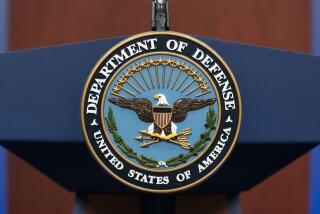Speedy Military Ships Move Into Place
- Share via
WASHINGTON — WASHINGTON -- Three of the Pentagon’s fastest cargo ships have left U.S. shores for Southwest Asian ports, carrying weapons and supplies that would be critical for any move against Iraq, defense officials said Thursday.
Two of the ships, the Bob Hope and the Fisher, are carrying state-of-the-art portable bridges capable of moving large numbers of troops and heavy equipment across the Euphrates River quickly. The other, the Bellatrix, a smaller ship that travels even faster, left San Diego with a vast array of electronics, survival equipment, vehicles and supplies in its holds to support a Marine Corps expeditionary headquarters unit deploying this week from Camp Pendleton to the Persian Gulf.
The Bob Hope passed through the Suez Canal today. The Fisher is expected to do so in a few days.
The deployment of the ships, all part of the Pentagon’s “surge fleet” designed to deliver military equipment rapidly in a crisis, significantly boosts the amount of military hardware the Pentagon has positioned within striking distance of Iraq.
Military officials also said this week that they had chartered two commercial vessels to move ammunition and a tank from Germany to the Gulf.
“We’re repositioning equipment to support forces that are engaged in the war on terrorism,” said Marge Holtz, a spokeswoman for the Navy’s Military Sealift Command, which moved the bulk of the equipment used during the 1991 Persian Gulf War.
The Bob Hope departed Charleston, S.C., on Oct. 24 and the Fisher left there four days later. Both were loaded with oil tanker trucks and the “ribbon bridges” that Army engineering battalions would need to cross the wide Euphrates, which flows the breadth of Iraq and passes near Baghdad, the capital.
Military officials say it would be impossible to gain control of Iraq using airstrikes alone. Ground forces, however, would need to cross the Euphrates. The rapidly deployed bridges could play a crucial role, minimizing U.S. casualties by speeding large numbers of soldiers and heavy equipment across the river.
The bridging equipment and tankers are for use by the Army’s 34th Mechanized Infantry Division, according to a defense official who spoke on condition of anonymity.
He would not confirm whether elements of the division had been ordered to deploy to the Middle East from their base at Hunter Army Airfield in Savannah, Ga.
The Bob Hope and the Fisher are part of a fleet of 19 ships acquired and refitted by the military during the past decade at a cost of $6 billion to improve the way the Pentagon equips U.S. troops abroad.
The ships are outfitted with huge ramps designed to allow massive artillery pieces, Humvees and trucks to roll on and off. The design allows them to be unloaded much more rapidly than the cargo ships that were used to equip troops during the Gulf War. Those ships required giant cranes to painstakingly lift tanks and other heavy gear out of their holds. With the new ships, the ramps come down, and workers drive the vehicles ashore.
More than 900 feet long and 100 feet wide, each of the ships has a hold capacity of 380,000 square feet--equivalent to eight soccer fields.
Though the Bob Hope and Fisher are capable of carrying tanks, helicopters and other heavy artillery, neither is doing so this time.
In 1991, the Pentagon relied on slow, hulking commercial cargo ships conscripted into service to move massive amounts of ammunition, artillery pieces, fuel trucks and an array of supplies to Gulf ports.
Some of those ships were barely seaworthy. Others had to be taken out of river berths where they had sat for years. None had the ferry-like ramps and holds of the new fleet.
“We got it there by hook and by crook, and the reality is we weren’t able to get stuff in here as quickly as we wanted to kick off the ground war,” said former Marine Col. Jay Farrar, who worked for the Joint Chiefs of Staff when the military was working to procure the new fleet.
The need for the ships “became very apparent from that experience,” Farrar said.
“They are something that’s tailor-made to haul your equipment and get it there in good shape and that is dedicated to do that.”
Seven more of the new ships and six more fast sealift ships are berthed at U.S. ports. The ships are prepped to be ready to leave for anywhere in the world within four days of receiving orders.
More to Read
Sign up for Essential California
The most important California stories and recommendations in your inbox every morning.
You may occasionally receive promotional content from the Los Angeles Times.













